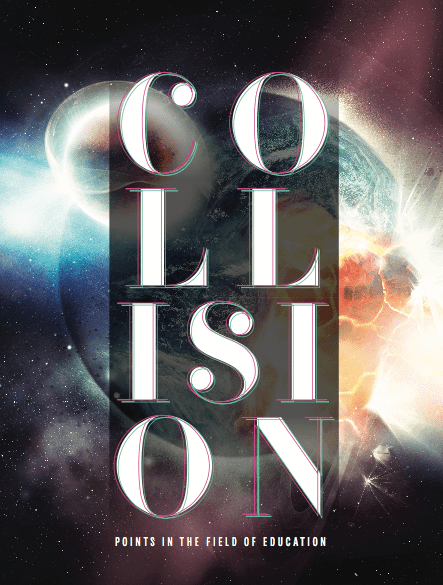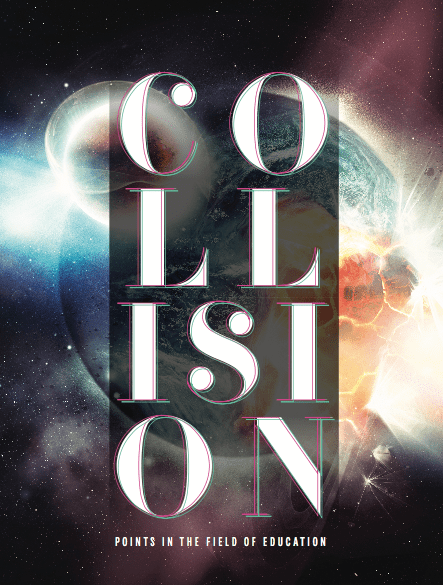

Collision Points in the Classroom
When we use the word collision in the School of Education at OKWU, we are referencing the collision of two worldviews: the biblical worldview and the secular worldview. For the School of Education at OKWU, the biblical worldview is grounded in our 4 P’s: The Primacy of Jesus Christ, The Priority of Scripture, The Pursuit of Truth, and the Practice of Wisdom. If we are not diligent about upholding the biblical worldview, we will be “captive through hollow and deceptive philosophy, which depends on human tradition and the basic principles of this world rather than on Christ” (Colossians 2:8). We take the infusion of a biblical worldview seriously because we want our students to be grounded in Christ and not deceived by the hollow and deceptive philosophy of the world.
 First and foremost, the biblical worldview defines and guides the very curriculum we teach in the School of Education. It is a falsehood that curriculum is a textbook or even a set of state or district standards. The curriculum in a teacher’s classroom is defined by his/her worldview; curriculum is everything that happens in that classroom. For a teacher with a biblical worldview, this means everything that happens in that classroom is derived from Scripture. A biblical worldview defines the mission of the classroom, the purpose of the classroom, our approach to assessment, the role of the learner, the role of the teacher, how we understand learning as a process, how we develop our lesson plans, how we interact with parents, how we interact with fellow faculty, and how we interact with administration. When people argue that God is no longer in our public schools, we need to remind them that our God is not limited by manmade buildings. God is omnipresent; He is everywhere. If our students are teaching in public schools, private schools, or charter schools, we want them to understand how their worldview informs everything they do in their classrooms.
First and foremost, the biblical worldview defines and guides the very curriculum we teach in the School of Education. It is a falsehood that curriculum is a textbook or even a set of state or district standards. The curriculum in a teacher’s classroom is defined by his/her worldview; curriculum is everything that happens in that classroom. For a teacher with a biblical worldview, this means everything that happens in that classroom is derived from Scripture. A biblical worldview defines the mission of the classroom, the purpose of the classroom, our approach to assessment, the role of the learner, the role of the teacher, how we understand learning as a process, how we develop our lesson plans, how we interact with parents, how we interact with fellow faculty, and how we interact with administration. When people argue that God is no longer in our public schools, we need to remind them that our God is not limited by manmade buildings. God is omnipresent; He is everywhere. If our students are teaching in public schools, private schools, or charter schools, we want them to understand how their worldview informs everything they do in their classrooms.
The second place where our biblical worldview collides with the secular worldview is in terms of truth. In many classrooms today, the secular worldview teaches students that anything they believe is truth. The biblical worldview teaches us that truth is found in in the person and example of Jesus Christ. Our example of great teaching is found in the truth presented about Jesus as a teacher. Our students take the Sermon on the Mount (Matthew 5-7) and analyze it as a lesson plan. What methods did Jesus use? How did He reach His students? Why did He use parables to teach abstract concepts to a crowd of literal thinkers? Truth comes from only Him, and how we approach truth in the classroom is modeled after His teaching. What better teacher model can we follow than our Savior?
The secular worldview will teach you that your individuality should be celebrated and that you should wave whatever banner you identify with loud and proud. The biblical worldview whispers our identity to us, ‘Imago Dei’.
Genesis 1:27 says, “God made man in His own image.” You are made in God’s own image. You. Yes, you. It doesn’t matter what your hair looks like or your face looks like. You were made in God’s own image. For the teachers who graduate from OKWU, this means that every single student who colors a picture or sits in a desk and takes notes was made in God’s image. This biblical worldview indeed collides with the secular worldview because it quietly reminds us that no matter who stands in front of us and no matter what they might be screaming about their identity, we know securely their identity is Imago Dei.
A third place where the biblical worldview collides with the secular worldview for the OKWU School of Education is the focus on the intentional inclusion of the marginalized students. Hallowell (2011) defines people who are marginalized as those who are on the outside of the main group. The secular worldview encourages people to find the way you are different and use that as a reason to stay on the outside. The biblical worldview is all-inclusive; Jesus Christ came to save everyone. As we train teachers, we discuss how people are marginalized and how Christ went out of His way to include those people. The list of marginalized people Jesus reach out to include is vast: Mary Magdalene, Zacchaeus, the woman at the well, the disciples themselves were marginalized by society for one reason or another. As teachers, we remind our candidates that reaching the marginalized student is a biblical mandate. When our teachers are in the classroom, we train them how to find the marginalized students and how to embrace them with the open arms of Christ. We teach them the importance of inclusion and help them learn to love all of their students as Christ loves them.
Remember that wreckage that came to your mind when you first thought about the word collision? The OKWU School of Education challenges their students and you to choose to see the face of Christ, not colliding with the world but standing there. Christ is not wreckage. He is wholeness and healing. The biblical worldview collides with the secular worldview because it is right. The biblical worldview is the worldview where the marginalized are included and your identity secure. It is our honor, duty, and our pleasure to teach education students the biblical worldview of education.
Hallowell, E. M. (2011). Shine: Using brain science to get the best from your people. Boston, MA:
Harvard Business Review Press.